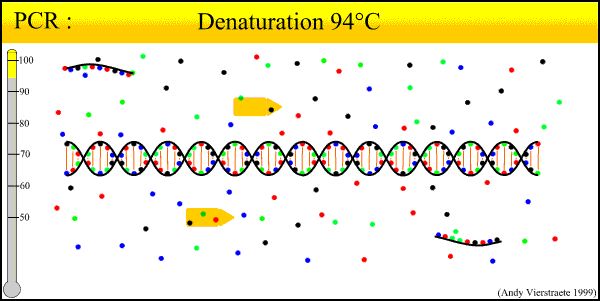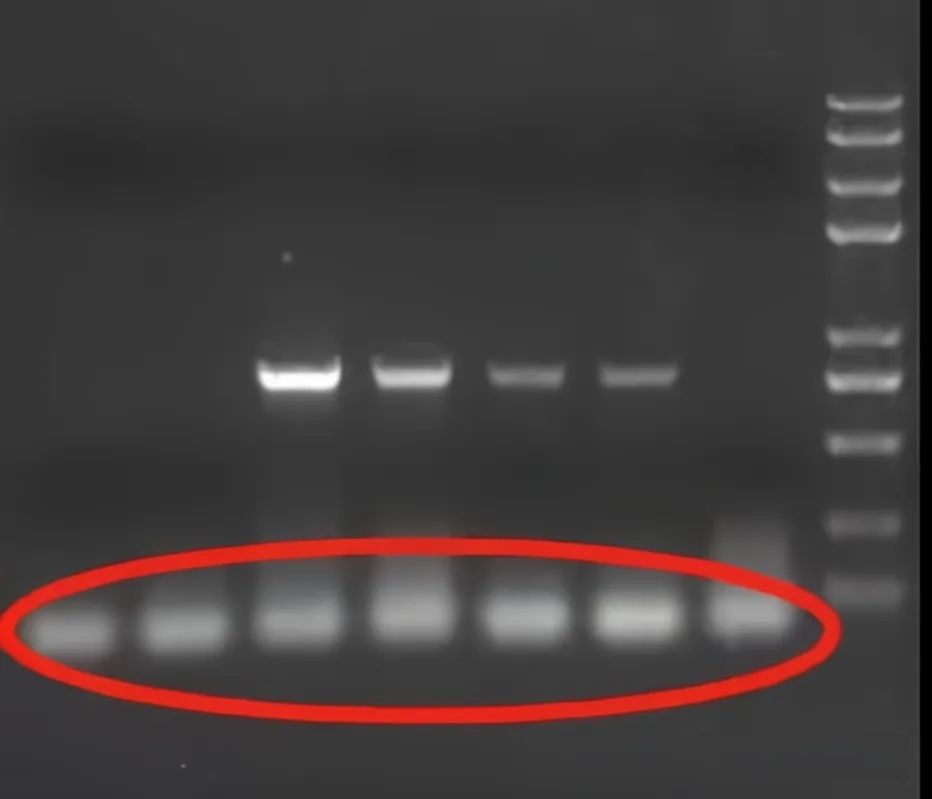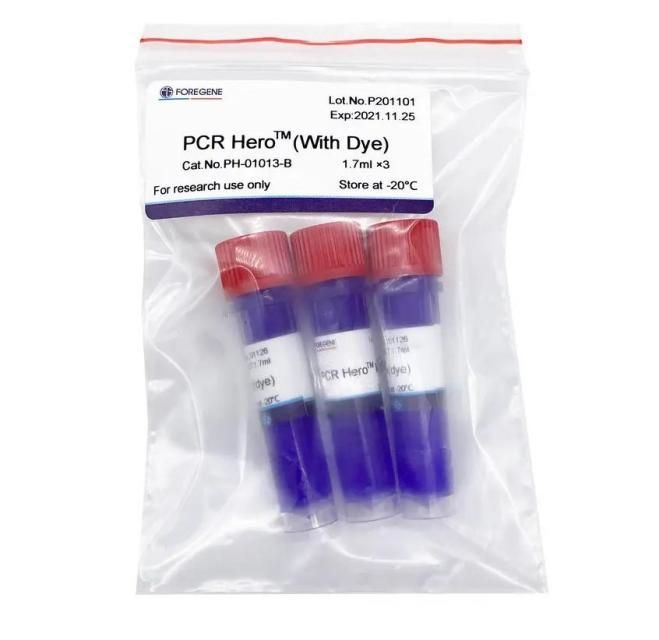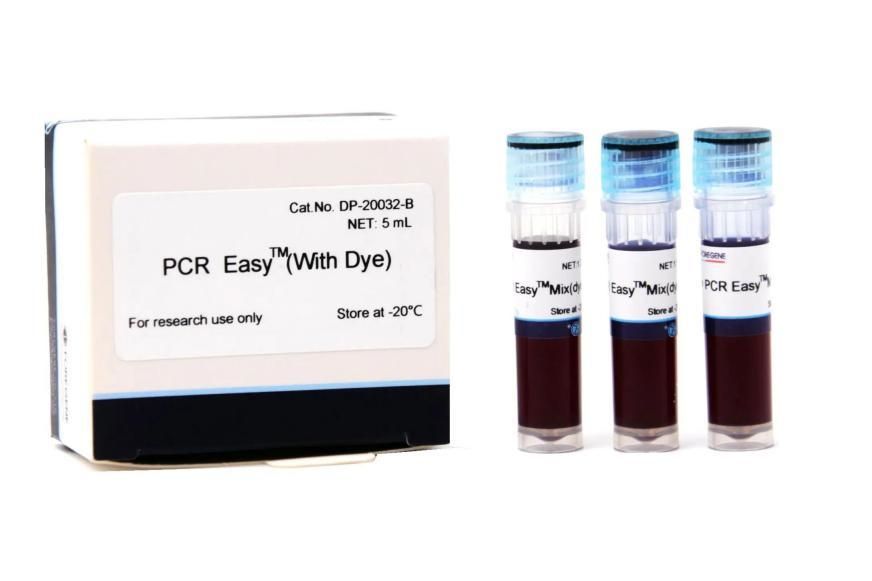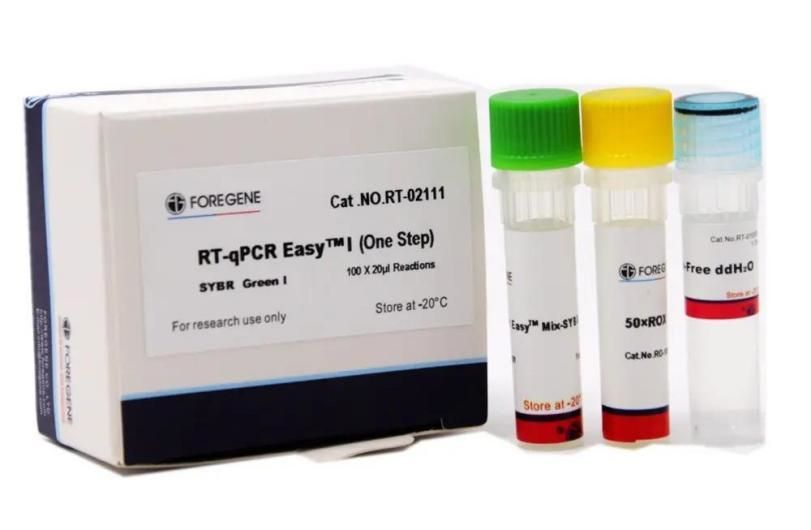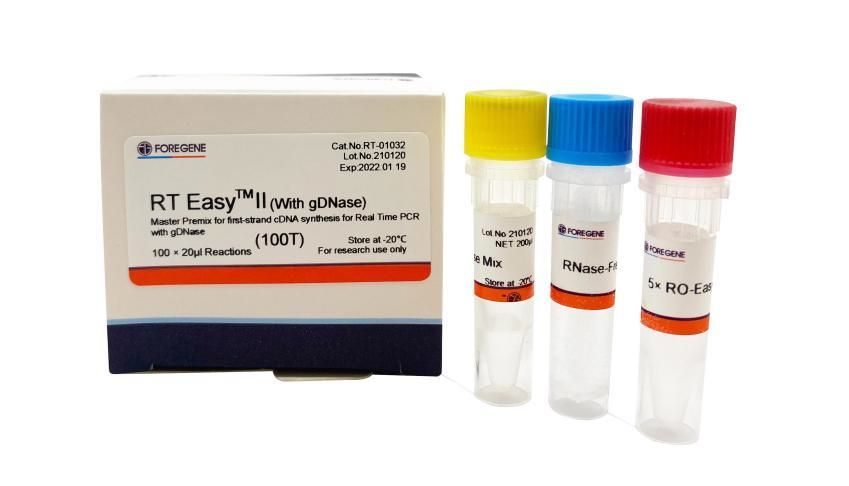PCR, multiple PCR, In situ PCR, Reverse PCR, RT-PCR, qPCR(1)– PCR
We will sort out the concepts, steps and details of various PCR
Ⅰ. PCR
Polymerase Chain Reaction, referred to as PCR, is a molecular biological technology that is used to enlarge specific DNA fragments. It can be regarded as a special DNA replication in vitro. DNA polymerase (DNA Polymerase I) was discovered as early as 1955, and Klenow Fragment of E. Coli, which has experimental value and practicality, was discovered by Dr. H. Klenow in the early 1970s, but because this enzyme does not tolerate temperature, high temperature can degenerate it, so it does not meet the polymerase chain reaction with high temperature degeneration. The enzymes in use today (called Taq polymerase), were isolated from Thermus aquaticus, a hot spring bacterium in 1976. Its characteristic is that it can resist high temperature and is an ideal enzyme, but it is widely used after the 1980s. The original concept of the original primitive prototype of PCR is similar to gene repair and copying, which was proposed by Dr. KJell Kleppe in 1971. He published the first simple and short -term gene copy (similar to the first two cycle reactions of PCR). The PCR developed today was developed by Dr. Kary B. Mullis in 1983. Dr. Mullis served PE companies that year, so PE has a special status in the PCR industry. Dr. Mullis officially published the first related paper with Saiki and others in 1985. Since then, the use of PCR is thousands of miles a day, and the quality of related papers can be said to make many other research methods unpalatable. Subsequently, PCR technology is widely used in biological scientific research and clinical applications, becoming the most important technology of molecular biology research. Mullis also won the 1993 Nobel Prize in Chemistry.
PCR Principle
The basic principle of PCR technology is similar to the natural replication process of DNA, and its specificity depends on the oligonucleotide primer that is complementary to both ends of the target sequence. PCR is composed of degeneration-annealing-extending three basic reactions steps: ①Degeneration of template DNA: After the template DNA is heated to about 93°C for a certain period of time, the dual DNA solution for the dual-chain DNA formed by the PCR amplification of the template DNA Leaving, make it a single chain so that it can be combined with the primer to prepare for the next round reaction. ②The annealing (compound) of the template DNA and the primer: After the template DNA is heated and degenerated into a single chain, the temperature drops to about 55°C. The complementary sequence of the primer and the template DNA single-chain. ③The extension of the primer: DNA template-the primer binding is based on the action of TaqDNA polymerase, with dNTP as the reaction raw material. Keep the principle of replication, synthesize a new semi-reserved copy chain that complement the template DNA chain, and repeat cycle degeneration-annealing-extension three processes can get more “semi-reserved copy chain”, and this new chain is available again Become a template for the next cycle. It takes 2-4min to complete the loop, the target gene can be amplified several million times in 2-3 hours.
Standard PCR Reaction System
|
Taq DNA Polymerase |
2.5 μl |
|
Mg2+ |
1.5mmol/L |
|
10× amplification buffer |
10μl |
|
4 dNTP mixtures |
200μl |
|
Template DNA |
0.1~2μg |
|
Primer |
10~100μl |
|
Add double or triple steaming water |
100 μl |
Five elements of PCR reaction
There are mainly five kinds of substances involved in PCR reaction, namely primer, enzyme, dNTP, template and buffer (Mg2+ is required). [PCR procedure]
The standard PCR process is divided into three steps
1. DNA degeneration (90°C-96°C): Dual-chain DNA templates under thermal action, hydrogen bonds break, forming a single-chain DNA.
2. Annealing (25℃ -65℃): The system temperature is reduced, the primer is combined with the DNA template to form a local dual-chain.
3. Extension (70℃ -75℃): Under the action of Taq enzyme (about 72°C, the best activity), dNTP is used as the raw material, extend from the 5′ end of the primer → 3′ end, synthesis and template complement each other DNA chain.
Each cycle is denatured, annealed and extended, doubling the DNA content. At present, due to the short amplification area, some PCR can be replicated in a very short time even if the Taq enzyme activity is not optimal, so it can be changed to two steps, that is, the annealing and extension can be performed at 60°C-65°C at the same time. In order to reduce the process of lifting and cooling and improve the response speed.
PCR Reaction features
● High-Specificity
The specific decisive factors of the PCR response are: ①The specific combination of the primer and the template DNA. ②The principle of base pairing. ③The loyalty of the TaqDNA polymerase synthesis reaction. ④The specificity and conservativeness of the target gene.
The correct combination of primers and templates is the key. The binding of the primer and the template and the extension of the primer chain are based on the principle of alkaline base matching. The loyalty of polymerase synthesis reactions and the high temperature resistance of the Taq DNA polymerase to make the binding (compound) of the template and primer in the reaction can be performed at a higher temperature. The specificity of the combination is greatly increased. The clip can maintain a high degree of correctness. By selecting a target genetic region with high conservativeness and high conservativeness, its specificity is higher.
● High Sensitivity
The production volume of PCR products is increased by index, which can expand the starting template of Picker (PG=10-12) to increase the level of microcontroller to the level of micrograms (μg= -6). A target cells can be detected from 1 million cells; in the detection of viruses, the sensitivity of PCR can reach 3 RFUs (empty spots formed units); the minimum detection rate in bacterial science is 3 bacteria.
● Simple and Fast
The PCR reflection uses a high-temperature Taq DNA polymerase, which adds the reaction solution at one time, that is, a degeneration-anneal-extension reaction on the DNA amplification solution and water bath pot. Generally, the amplification reaction is completed in 2 to 4 hours. Augmented products are generally analyzed by electrical sword, and do not have to use isotopes, no radioactive pollution, and easy promotion.
● The purity of the specimen is low
There is no need to separate viruses or bacteria and culture cells. DNA crude products and RNA can be used as amplifiers. DNA amplification detection can be used directly using clinical specimens such as blood, body liquid, cough washing fluid, hair, cells, and living tissue.
PCR common problems
● False negative, no amplified bands
The key stages of the PCR reaction include: ① preparation of template nucleic acids, ② quality and specificity of primers, ③ the quality of enzymes ④ PCR cycle conditions. Finding the reason should also be analyzed and studied for the above links.
Templates: ① The template contains miscellaneous protein, ② The template contains a Taq enzyme inhibitor, ③ The protein in the template is not eliminated, especially the group protein in the chromosome. ⑤ Deminer nucleic acid degeneration is not thorough. When the quality of enzymes and primers are good, there is no amplification band, which is most likely the digestive treatment of specimens. There is something wrong with the template nucleic acid extraction process, so to prepare an effective and stable digestion solution, its procedure should be fixed and not arbitrarily changed.
Enzyme inactivation: a new enzyme or both old and new enzymes should be used together to analyze whether the enzyme activity is lost or insufficient, leading to false negatives. It should be noted that Taq enzyme or ethidium bromide is sometimes forgotten.
Primer: the quality of the primer, the concentration of the primer, and whether the concentration of the two primers is symmetrical. It is a common reason for the PCR failure or the increasing band is not ideal and prone to diffuse. There are problems with the quality of the primers of some batch numbers. The two primers have a high concentration and a low concentration, causing low -efficiency asymmetric amplification. The countermeasures are: ① Select a good primer to synthesize units. ② The concentration of the primer not only depends on the OD value, but also pays attention to the primer’s original liquid to make agar sugar gel electrophoresis. There must be a primer strip zone, and the brightness of the two primers should be generally consistent. Belt, PCR may fail at this time, and it should be resolved with the primer synthesis unit. If a primer is high, the brightness is low, and its concentration must be balanced when diluted. ③ The primer should be paid and stored at a high concentration to prevent multiple freezing or long -term refrigeration parts of the refrigerator, which will cause the primer to deteriorate and degrade. ④ The design of the primer is unreasonable, such as the length of the primer is insufficient, and the di cluster is formed between the primers.
Mg2+concentration: Mg2+ion concentration has a great impact on PCR amplification efficiency. Excessive concentration can reduce the opposite sex of PCR amplification. If the concentration is too low, the PCR amplification output will even make the PCR amplification failure without the expansion band.
Change of reaction volume: The volume used in PCR amplification is 20ul, 30ul, and 50ul or 100uL, the large volume of the application for PCR amplification is set according to different purposes of scientific research and clinical testing. After making small volumes such as 20ul, it is necessary to make a cord condition when making the size, otherwise it will fail.
Physical reasons: Transformation is very important for PCR amplification. If the degeneration temperature is low, the degeneration time is short, it is likely to occur in false negatives; too low annealing temperature can cause non -specific amplification and reduce specific amplification efficiency. Highly affect the combination of primers and templates to reduce PCR amplification efficiency. Sometimes it is necessary to use standard thermometers to detect the variability, annealing and extended temperature in the extension or water -soluble cooker, which is one of the reasons for the failure of the PCR.
Target sequence variants: If the target sequence occurs, a mutation or deletion, the combination of the prototype and the template is combined, or due to the lack of a target sequence, the primer and the template will lose the complementary sequence, and its PCR amplification will not be successful.
● False positive
The PCR amplification band appears consistent with the target sequence band, and sometimes its band is more neat and higher.
Primer design is not appropriate: the selected amplification sequence and non -purpose amplification sequence have homologous, so when PCR amplification, the amplified PCR products are non -purposeful sequences. The target sequence is too short or the primer is too short, and it is prone to false positive. Need to be redesigned.
Cross pollution of target sequence or amplification products: There are two reasons for this pollution: First, cross -pollution of the entire genome or large segments, leading to false positives. This kind of false positive can be solved by the following methods: Be careful and gentle during operation to prevent the target sequence from inhaled into the sample gun or splash out of the centrifugal tube. Except for enzymes and substances that cannot withstand high temperatures, all reagents or equipment should be disinfected with high pressure. The centrifugal pipes and samples should be used at one time. When necessary, before adding specimens, the reaction tube and reagent are exposed to ultraviolet rays to destroy the existing nucleic acid. Second, small fragments in the air pollution. These small fragments are shorter than the target sequence, but they have certain homology. It can be spliced with each other. After complementing the primers, the PCR product can be expanded, which will cause false positive production. It can be used to reduce or eliminate the nest PCR method.
● Appear nonspecific amplification band
The bands that appeared after PCR amplification are inconsistent with the expected size, or large or small, or at the same time, or at the same time, specific amplification bands and non-specific amplification bands. The emergence of non-specific bands is: First, the primers are incomplete complementary to the target sequence, or the polymerization of the primer to form a di cluster. The second is that the concentration of MG2+ions is too high, the annealing temperature is too low, and the number of PCR cycles is related. Secondly, the quality and amount of enzymes. Often, enzymes of some sources are prone to non-special bands and the enzymes of the other source are not occurred. Sometimes non-specific amplification of enzymes also occur. The countermeasures are: re-designed attractives if necessary. Reduce the amount of enzyme or replace the enzyme of another source. Reduce the amount of primary, increase the amount of templates appropriately, and reduce the number of cycles. Properly increase the annealing temperature or use the two temperature point method (93°C degeneration, annealing and extending at about 65°C).
● Appear flaky tow or smear tape
PCR amplification sometimes appears to be applied or shelled or carpet -like belt. For the reason, due to the excessive amount of enzymes or the poor quality of the enzyme, the dNTP concentration is too high, the Mg2+ concentration is too high, the annealing temperature is too low, and the number of cycles is too much. The countermeasures are: ①Reduce the amount of enzymes, or change the enzyme of another source. ②Reduce the concentration of dNTP ③Properly reduce Mg2+ concentration. ④Increase the quantity of templates and reduce the number of cycles.
Related Products
◮ Higher fidelity: 6 times that of ordinary Taq enzyme;
◮ Faster amplification speed
◮ More template adaptability
◮ Higher amplification efficiency
◮ Environmental tolerance is stronger: placed at 37°C for a week, maintaining more than 90% activity;
◮ It has 5’→3’ DNA polymerase activity and 5’→3’ exonuclease activity, without 3’→5’ exonuclease activity.
The unique reaction system and high-efficiency Taq DNA Polymerase make the PCR reaction have higher amplification efficiency, specificity and sensitivity.
RT-qPCR Easyᵀᴹ (One Step)-SYBR Green I
◮ One-step kit makes reverse transcription and qPCR two reactions in the same tube, only need to add template RNA, specific PCR primers and RNase-Free ddH2O.
◮ The kit can quickly and efficiently quantitatively analyze viral RNA or trace RNA.
◮ The kit uses a unique Foregene reverse transcription reagent and Foregene HotStar Taq DNA Polymerase combined with a unique reaction system to effectively improve the amplification efficiency and specificity of the reaction.
◮ The optimized reaction system makes the reaction have higher detection sensitivity, stronger thermal stability, and better tolerance.
◮ RT-qPCR EasyTM (One Step)-SYBR Green I kit comes with ROX internal reference dye, which can be used to eliminate signal background and signal errors between wells, which is convenient for customers to use in different models of quantitative PCR instruments.
RT EasyTM II (Master Premix for first-strand cDNA synthesis for Real Time PCR)
-Efficient ability to remove gDNA, which can remove gDNA in the template within 2 minutes.
-Efficient reverse transcription system, it only takes 15 minutes to complete the synthesis of the first strand cDNA.
-Complex templates: templates with high GC content and complex secondary structure can also be reversed with high efficiency.
-High-sensitivity reverse transcription system, pg-level templates can also get high-quality cDNA.
-The reverse transcription system has high thermal stability, the optimal reaction temperature is 42℃, and it still has good reverse transcription performance at 50℃.
Post time: Mar-18-2023





